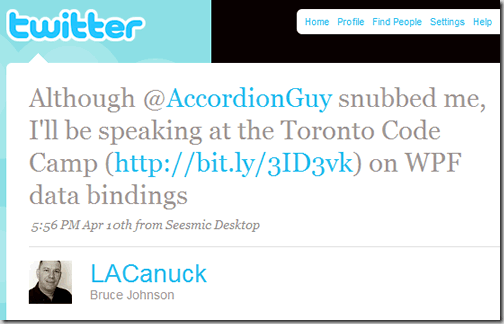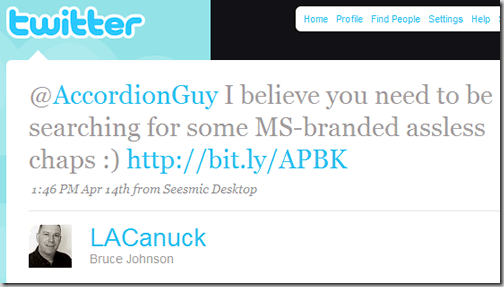Before I begin, let me state that yes, I know that chaps, by definition, have no seat and that the phrase “assless chaps” is redundant. By adding “assless” to chaps, I am simply following one of the golden rules of comedy, namely that adding butt-related humour to anything always makes it funnier.
The Snub and the Challenge
How I came to end up wearing assless chaps on Saturday started innocently enough. I wrote an article about Toronto Code Camp in which I talked about the sessions I was thinking of attending. One of the presenters, Bruce Johnson of ObjectSharp, saw that I didn’t mention his presentation and tweeted that I’d snubbed him:

Actually, learning WPF was on my “to-do” list, so I let Bruce know that I actually was coming to his presentation. In my tweets to him, I fired off this jokey reply:

I figured that I was at very little risk at having to follow through with this promise. Had this been FutureRuby or perhaps some open source conference, I’m sure my challenge would’ve been answered, but I thought: Hey, this is a conference of Microsoft developers! Yes, they’re a bright and talented bunch, and I like them, but they’re an older, corporate, more buttoned-down crowd. They’d never go for renaming a session from “Data Binding” to “Data Bondage”.
But Bruce and the Toronto Code Camp organizers surprised me:

I was actually impressed. I was even a little ashamed that I’d brought some prejudices about Microsoft developers from the open source world with me, thinking that they wouldn’t be cool enough to handle slightly edgy content. Live and learn.
Malabar to the Rescue
“A promise made is a debt unpaid,” as the narrator in the classic poem The Cremation of Sam McGee says, so I made arrangements to get my hands on (or more accurately, ass into) some assless chaps. Luckily, Toronto has Malabar. It’s a great costume shop located on McCaul Street just of Queen West, and they’ve been a great source of costumes for years. That’s where the Ginger Ninja and I got our outfits for Cory Doctorow’s steampunk-ish wedding back in October:

Getting the chaps was easy. I walked into Malabar and simply said “I’d like to rent some chaps, please.”
“What kind?” the woman behind the counter asked.
“The S-and_M-ier, the better.”
“I know just the pair,” said one of the guys. “Let me get them from the basement.”
Malabar rocks.
Putting the “Camp” in “Code Camp”
At this point, you’re probably saying, please Joey, for the love of all things holy, tell me that you wore something under the chaps.
To which I’ll answer: “Yes. Yes I did.” I wore my loudest pair of jeans, a pair of striped jeans in crazy colours that I’ve had since my days at Crazy Go Nuts University, back when I used to go to raves. They went well with the chaps, as you can see in the photo below:

I did promise that the assless chaps would be Microsoft-branded; this was fixed thanks to Colin Bowern giving me an “I’m a PC” sticker that he happened to have in his knapsack:

Later in the afternoon, I ran to the store to get a Diet Coke and saw my reflection in the mirrored windows of a neighbouring building. “Damn, I look good!” I thought.
And as proof of their asslessness, here’s a photo of the chaps from behind. Ladies, please control yourselves; I’m already spoken for!

I walked into Bruce’s presentation moments after everyone was seated and regaled them with Britney Spears’ Baby One More Time, spiced up with a little extra butt-wiggling and ending with rousing applause:

…after which I sat down in the front row to catch Bruce’s presentation. It was quite good, and I did learn a lot about data binding in WPF – certainly enough for me to start exploring that aspect of Windows and Silverlight programming. Just as important – if not more so – I learned that the Windows developer community is cooler than one might be led to believe. Both were good lessons.













